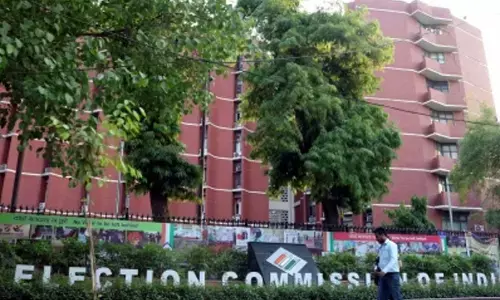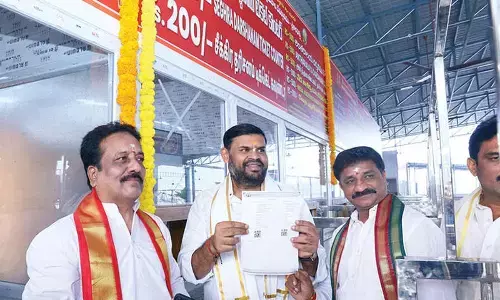Metal Magic

Metal Magic
I still recall the thrill with which we, six classical-music students just out of college, took home a memento made of Pembarthi metal craft.
I still recall the thrill with which we, six classical-music students just out of college, took home a memento made of Pembarthi metal craft. We had participated in a Carnatic-music veena ensemble programme and were gifted these shining, brass wall-plates with a figure of Saraswathi, the goddess of learning.
Many years later, I visited Pembarthi village near Warangal, Telangana, and saw the skilled artisans who created these objects of beauty with so much patience. I have visited the village several times over since then as Warangal is a place that has drawn me many times. Pembarthi is a short distance from this heritage city of Warangal. If you want to go directly, this village is approximately 85 km from Hyderabad.
These exquisite handmade brass products have a long history. Sheet metal craft from the eponymous village in Telangana is centuries old. It flourished during the era of the famous Kakatiya dynasty when it was used extensively to embellish and decorate chariots and temples. It was also used for the dhwajastambham or flagpole which one sees as soon as one enters a large temple. Brass idols as well as the brass covering or kavacham of a stone idol as also other temple accessories were also made by these highly talented craftspersons.
For those who need to know, the Kakatiya dynasty was a famous royal house of south India which ruled the eastern Deccan region including present-day Telangana and Andhra Pradesh as also parts of eastern Karnataka and southern Odisha from the middle of the 12th century (approx) AD to the 14th century AD . The Kakatiyas are credited with the building of many great temples in this region and herein one can see the stamp of Pembarthi craftspersons. Royal patronage was very important to art and craft in the days of kings and queens i.e. so when the dynasty declined so did the art. The practitioners also dwindled. Later, with the rise of the Nizams, the art saw a boost again. Today, the craftsperson's not only sell their brassware around Telangana and rest of India but also export them to Western countries.
Today, you will find several homes in Pembarthi where a room or two or backyard has been converted into a workshop where this art is practised. Among the most popular items sold by Pembarathi craftspersons are the gangalam or big brass vessel, the kalasam or vessel with Dasavatharams on them (the 10 avatars of Vishnu) and Ashtalakshmi (the eight forms of Goddess Lakshmi). These two are popular not only in home decoration but also as gift items for occasions like weddings, housewarming and such auspicious functions. Another item which can actually be called a signature item is the Kakatiya kirthi thoranam or the arch of victory. This item is also sold as a sheet on a wooden background with a wooden base. This is frequently given as a souvenir item for participants and guests in school and college functions, official get-togethers and government functions. Rivalling this in popularity is the Nandi (the bull fronting the Shiva in the sanctum-sanctorum). A figure of Bharat Mata against the backdrop of the map of India is another popular product. Wall plates or wall hangings made here are available for sale in big numbers at this village and in handicraft stores around Telangana and Andhra Pradesh. A figure of Bharat Mata against the backdrop of the map of India is another popular product.
Among the specially customised items made in Pembarthi are ornate front doors for homes where the wooden door has sheets of finely crafted brass. Such decorative doors to puja rooms are also made by these craftspersons. Puja mandaps and mirrors with brass frames are other such objects customers want made especially for their homes. All of them are testimony to the outstanding skills and creativity of the Pembarthi artisans. Besides brass, they also create panchaloha idols (panchaloha means made with five metals) and artefacts in silver metal too.
Aila Venkateswarulu, Sampada Chary and Seenu Chary are among the well-known practitioners of this art. They gave us much information and interesting insights into the evolution of this art when we visited this village the last time, a few years ago.
However, not everyone in Pembarthi practises this profession. There are around 100 families here of which around 10 to 12 are involved in this art. As the elders of a few families told us: "This is about handmade objects. It requires a great deal of time and patience and is literally about back-bending effort. The hammering and embossing all call for hard work in humble, rural surroundings. The earnings are also not very high. Hence, many youngsters prefer desk jobs especially the one where one can sit before a computer in an air-conditioned room and take home a comparatively bigger salary."
These craftspersons have learned to move with the times. They have expanded their product range to a large variety of items. The willingness to take customised orders and create them to precision has also increased their reputation and appeal. Some of them take online orders and also maintain websites to promote their art. Hopefully, their art will survive for the next few centuries too as it has for the past few ones.















